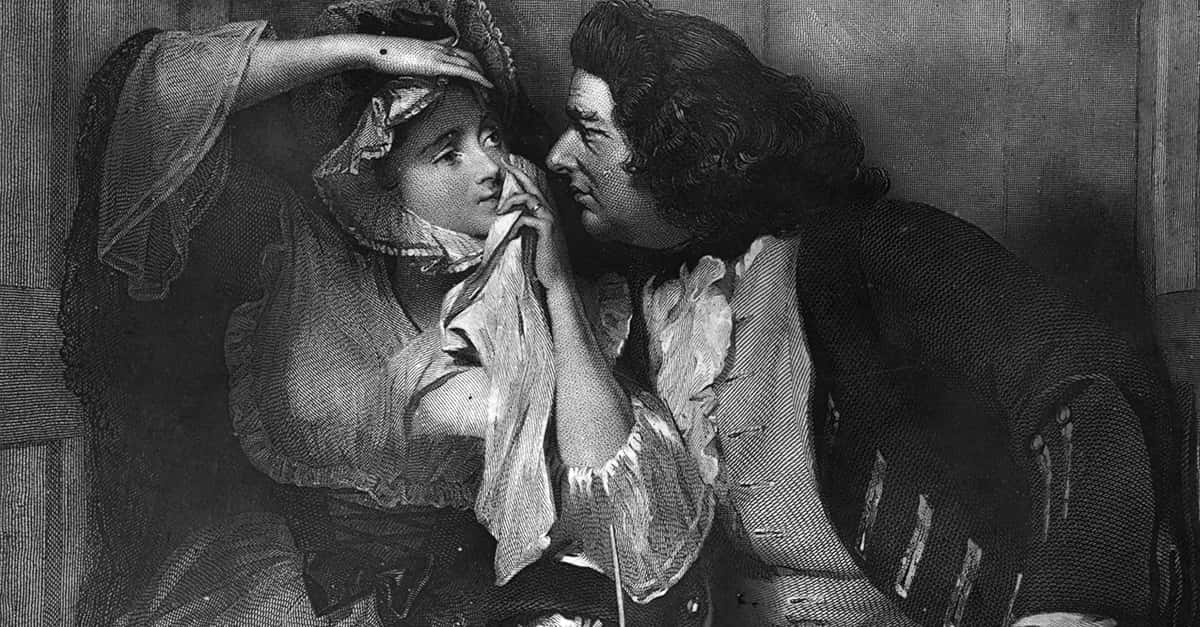In 1761, the aristocrat Horace Walpole picked up his quill and got something off his chest. After reading four volumes of the latest bestseller, Laurence Sterne’s The Life and Opinions of Tristram Shandy, Gentleman (1759-62), Walpole was done. To Walpole, the book offered only “the dregs of nonsense” and he felt pleased to see fellow naysayers give it “the contempt [it] deserved.”
Walpole was not alone in disliking Tristram Shandy. Both bawdy and baffling, this controversial novel excited and appalled readers in equal measure. And even now, in a time when Tristram is now a classic, the book remains notorious for being one of the strangest things ever written.
Why did Tristram Shandy cause such a ruckus? Figuring out this peculiar novel means exploring the difference between art and life, questioning the kinds of books we consider “normal,” and thinking about how we would tell our own life stories.
Sterne’s Never-Ending Story
Trying to summarize Tristram Shandy is nearly impossible because this bizarre book doesn’t play by the rules. Instead of introducing characters, producing conflict, and chugging along to a resolution, Tristram Shandy throws these narrative elements at a wall and sees if they stick.
 Wikimedia Commons Detail of a portrait of Laurence Sterne, author of Tristram Shandy.
Wikimedia Commons Detail of a portrait of Laurence Sterne, author of Tristram Shandy.
The novel begins with Tristram wondering where to start his story and deciding that he may as well begin at his birth (a reasonable idea). But our narrator quickly realizes that if he wants to tell readers about his entrance into the world, he should probably discuss his conception.
And if Tristram wants to describe his conception, he must account for his parents’ weird bedroom-based idiosyncrasies.
And if Tristram wants to write about the Mr. and Mrs. Shandy’s intimate encounters, he has to tell readers about the hallway clock.
And on and on and on it goes.
Tristram walks the story of his life back to its most extreme point, then remembers what he’s trying to do, and lurches forward in time—only to get distracted by something else.
A Novel Approach
For readers like Horace Walpole, this kind of story-telling is exhausting—but Tristram disagrees. He treasures this aspect of the novel, calling his stories “digressions” and reminding his reader that they are the “sunshine of life.”
Most academics and Sterne fans would agree. Tristram’s zany structure makes rather than breaks the story. While Walpole hated that Sterne rebuffed a normal narrative structure, this so-called defect is where Sterne's brilliance lies. The endless digressions are insightful and important precisely because they are unlike most novels. Tristram is a masterpiece because it bucks literary convention and does something entirely different.
 Wikimedia Commons Detail of a portrait of Horace Walpole
Wikimedia Commons Detail of a portrait of Horace Walpole
Through Tristram’s madcap narration, Sterne asks readers to examine how “normal” novels work in the first place. A story that plods along from Point A to Point B seems natural because we’re used to linear, coherent storytelling—but to even have a plot or a genre in the first place, the writer has to know what’s going to happen. Once they know, they can decide the moments to focus on, the boring years to skip, the side characters to highlight, the people to ignore. It turns out that a “normal” narrative is really constructed.
The coherence of “conventional” stories is utterly fantastical compared to the messiness of real life. In our actual existence, it’s impossible to tell which days are special and which are normal, what will gain significance, and what’s just a blip on the radar.

Sign up to our newsletter.
History’s most fascinating stories and darkest secrets, delivered to your inbox daily. Making distraction rewarding since 2017.
The Worst Narrator—or the Best?
Sterne explores this tension with his unique narrator. In many ways, Tristram Shandy is not a very good storyteller. He gets distracted and rambles. He moves back and forth between storylines. When it suits him, he sticks in black and blank pages instead of using his words. He skips a whole chapter only to loop back ages later, and at the very end of the book, he just cuts off! Some reward for sticking with Tristram for 750 pages.
But through Tristram’s apparent incompetence, Sterne points out just how weirdly in-control most narrators are of their own messy life stories. If you were to sit down and try to write down your life story, your mind would probably work the way Tristram’s does. You’d start with one point, get reminded of something else, then work your way from there. You'd move through a vast, complicated network of associations, reminders, and memories that don’t follow a linear structure.
Working with John Locke’s philosophical ideas, Sterne shows how memory rarely moves from A to B to C. Unlike narrators who sit in armchairs effortlessly explaining their lives, the present-day pops in to disrupt Tristram's attempts to express himself. Sterne is interested in being honest about the jumbly, interruptive process of life and memory, not the squeaky-clean narrative that we’ve all read a thousand times before.
Soothed by Stories
But Sterne isn’t just doing something new for the sake of novelty. He’s urging readers to examine the basic elements of the books they read and question why they find them so pleasant—and conversely, why his more realistic structure is so strangely unpleasant. If Tristram writes the way we all think, why is his book so frustrating to read? Shouldn’t we feel at home in our own heads?
Maybe not. Many readers didn’t feel comfortable with the dissociation and randomness of Tristram’s story. In turn, this might suggest that humans like conventional narratives because they give us the kind of clarity and coherence that our real lives lack.
No Man is an Island
It’s scary to be confronted with the arbitrariness of life—but Tristram genuinely doesn’t want his readers to be afraid, and neither does Sterne. The author was actually a man of faith, an Anglican parson who marvelled at the wonder of humanity.
One of the things that is especially moving about Tristram Shandy is that while attempting to tell the story of his own life, Tristram ends up focusing on his family and friends. We learn about the maidservant Susannah, gentle Uncle Toby, two swearing nuns, a man with a huge nose, and many more zany, charming figures.
 Getty Images A portly man smoking a pipe assists a young woman with something in her eye, in an illustration from Laurence Sterne's novel 'The Life And Opinions Of Tristram Shandy, Gentleman'. Engaved after a painting by C R Leslie.
Getty Images A portly man smoking a pipe assists a young woman with something in her eye, in an illustration from Laurence Sterne's novel 'The Life And Opinions Of Tristram Shandy, Gentleman'. Engaved after a painting by C R Leslie.
It turns out that Tristram’s life is not his own, but something that he shares with the people around him. While conventional novels prioritize the protagonist, Tristram takes the time to think about how he is formed by his surroundings and, generously, to give his surroundings so much credit that they come to share his story in an equal, if not greater, part than himself.
A Novel for the People
Nowadays, we’re used to books and movies that break the fourth wall or call attention to their own status as artifice. Often, this is just a wink to the audience, a way of smugly saying, “I know I’m a book you’re reading” before moving on.
But Tristram Shandy actually pauses and thinks about what it would mean to question the baseline assumptions of literature: the idea that the narrator is in total control of their story, the idea that a life can be expressed in one clear line from beginning to end, and most importantly, the idea that one life can be extricated from all the lives that surround it.









